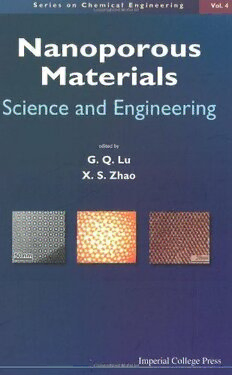
Nanoporous materials: science and engineering PDF
917 Pages·2004·43.771 MB·English
Most books are stored in the elastic cloud where traffic is expensive. For this reason, we have a limit on daily download.
Preview Nanoporous materials: science and engineering
Description:
Porous materials are of scientific and technological importance because of the presence of voids of controllable dimensions at the atomic, molecular, and nanometer scales, enabling them to discriminate and interact with molecules and clusters. Interestingly the big deal about this class of materials is about the "nothingness" within -- the pore space. International Union of Pure and Applied Chemistry (IUPAC) classifies porous materials into three categories -- micropores of less than 2 nm in diameter, mesopores between 2 and 50 nm, and macropores of greater than 50 nm. In this book, nanoporous materials are defined as those porous materials with pore diameters less than 100 nm. Over the last decade, there has been an ever increasing interest and research effort in the synthesis, characterization, functionalization, molecular modeling and design of nanoporous materials. The main challenges in research include the fundamental understanding of structure-property relations and tailor-design of nanostructures for specific properties and applications. Research efforts in this field have been driven by the rapid growing emerging applications such as biosensor, drug delivery, gas separation, energy storage and fuel cell technology, nanocatalysis and photonics. These applications offer exciting new opportunities for scientists to develop new strategies and techniques for the synthesis and applications of these materials. This book provides a series of systematic reviews of the recent developments in nanoporous materials. It covers the following topics: (1) synthesis, processing, characterization and property evaluation; (2) functionalization by physical and/or chemical treatments; (3) experimental and computational studies on fundamental properties, such as catalytic effects, transport and adsorption, molecular sieving and biosorption; (4) applications, including photonic devices, catalysis, environmental pollution control, biological molecules separation and isolation, sensors, membranes, hydrogen and energy storage, etc.
See more
The list of books you might like
Most books are stored in the elastic cloud where traffic is expensive. For this reason, we have a limit on daily download.
